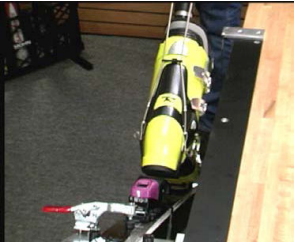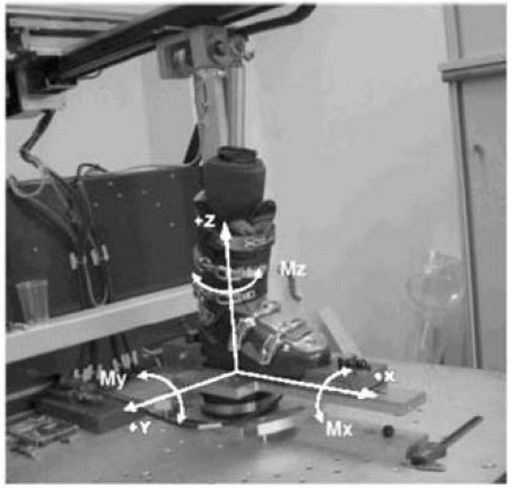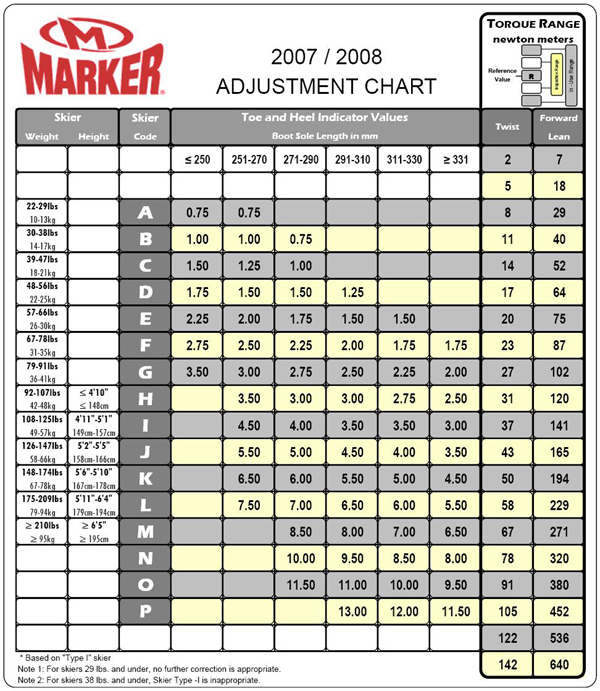|
No matter how recently you bought your last pair of bindings, your entire release system--boot, binding, and ski--should have a complete in-shop inspection before the start of each season and after every 15 to 30 days of use.
Source:
VERMONT Ski Safety Research FAQ
Checking Bindings:
-
The Self Test for Alpine Skiers - www.ski-injury.com - Ski Injury
This self release test has been demonstrated by several research groups to reduce the risk of knee injuries by up to 25%
Be careful. I ruptured my Plantaris tendon and partial tore the gastrocnemius doing this on a Marker MRR Race Bindings that were adjusted to race mode (effective DIN > 10 .)
At
New binding release testing | epicski.com they say,
The "right" way to do this (and put nearly zero tension on your achilles) is to not flex at the ankle, but rather, keep your ankle locked at one angle, and use your weight and your lower leg as a lever to try to pry upwards at the heel of your boot. You will feel the ball and toes of your foot pressing strongly downwards, while your heel is prevented from rising out of the boot by the top of your foot (just in front of your ankle) running into the inside of the boot between the 2nd and 3rd buckles (on a 4 buckle boot).
Vermont Ski Safety makes a
Release Calibrater to test bindings.
The
complete kit costs $5,700, but you can buy individual components.
Vermont Release Calibrater Operation and Maintenance Manual
 
How to Adjust Ski Bindings: 10 Steps (with Pictures) - wikiHow

Materials, Designs and Standards Used in Ski-Boots for Alpine Skiing | Materials Engineering, University of Bologna
Bindings supported:
Most ski shops will not adjust or test bindings not on the Indemnified Bindings list published by the snowboard retail trade association .
My Marker MRR Racers were not on the list.
At Indemnified ski bindings 2014-2015 | gondyline.com they say,
Remember that the ultimate determination of whether or not a shop will work on a binding is the opinion of the technician.
After 3 attempts I found a shop with a good reputation that would work on my Marker MRRs since they were still in good condition since I've not been skiing regularly.
At What is an Indemnified Binding? there is a discussion about whether manufacturers list a binding as obsolete because it is not safe or whether or because they want to sell you new bindings.
One person said they are using a lot of plastic now so they will age (or at least appear aged) faster. I don't think there was any plastic on my Look Nevadas which were popular from 1950 to 1990.
DIN Settings:

Ability:
Type 1 - Cautious skiing at lighter release/retention settings. Skieers who designate themselves "1" must accept a narrower margin of retention in order to gain a wider margin of release.
Type 2 - Average/moderate skiing at average release/retention settings. Skiers who designate themselves "2" must accept a balanced compromise between release and retention.
Type 3 - Aggressive, higher speed skiing at higher release/retention settings. Skers who designate themselves "3" must accept a narrower margin of release in order to gain a wider margin of retention.
Type 3+ - For skiers who desire visual indicator settings higher than settings for a Type 3 skier.
Step 1
Find the Release Code (letter A through P) which corresponds to the skier's weight, as well as the Release Code which corresponds to the skier's height. If they are not the same, choose the one that is closer to the top of the chart. For example if the skier's weight is 175 lbs. (code L) and the height is 5'7" (code K), choose code K as the correct line of the chart to be reading.
Step 2
Make the adjustments for skier type and age.
The selecton from Step 1 is for an "1" type skier. If the skier is "2" move down the chart one code. If the skier type is "3" move down the chart two codes. If the skier is age 9 or under, or age 50 or over, move up the chart one code.
Note and record the final Release Code letter for the skier.
Ski Binding DIN chart | DINsetting.com
Links:
- Ski Shops
Downhill Ski Bindings: How to Choose
-
Binding FAQ
at
Vermont Safety Research.
-
Testing Of Cross-Country Ski Shoes Using An Industrial Robot, Jozef Stefan Institute, Ljubljana, Slovenia, Department for Automation, Biocybernetics and Robotics.
-
Snowboard Step-in Bindings Requirements and Test Methods at iso.org
- The effect of boot stiffness on field and laboratory flexural
behavior of alpine ski boots,
International Sports Engineering Association 2013
at
ResearchGate.net
skikinetics | The Skier's Manifesto | Page 14
Ski Boots | The Skier's Manifesto
indemnified ski bindings 2014-2015 | gondyline.com
Adjusting Ski Bindings – How to Adjust Ski Bindings Right? | Homeboy
|  Sports
Sports
 Skiing
Skiing
 Injuries
Injuries
 Ski Binding Testing and Safety
Ski Binding Testing and Safety
 Sports
Sports
 Skiing
Skiing
 Injuries
Injuries
 Ski Binding Testing and Safety
Ski Binding Testing and Safety